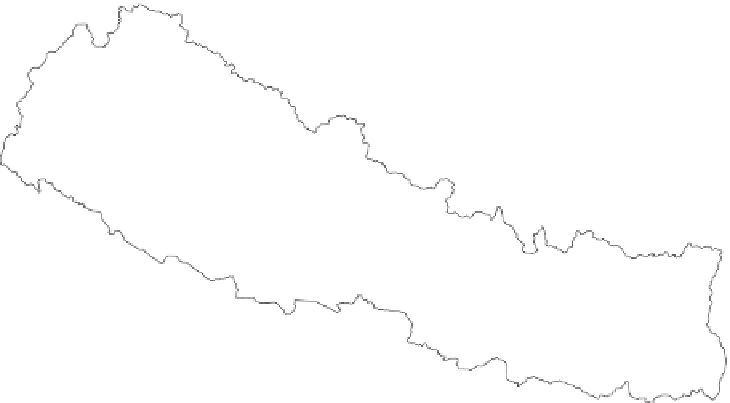Geography Reference
In-Depth Information
Figure 6.13. Flow regime classes
across Nepal (1
-
3: increasing regime
magnitude; A: July
-
August peak,
B: August
-
September peak,
C: marked August peak). From
Hannah et al.(
2005
).
1A
1C
2C
3C
2A
3A
1B
2B
Major Basin Divide
0
50
100
150 km
Physiographic regions
clearly discontinuous in space, but identify basin-by-basin
physical and climatic controls on the flow regime, includ-
ing basin latitude and longitude (which determine proper-
ties of the monsoonal rainfall); basin area above the
snowline (i.e., melt-water contributions); basin geology
(i.e., groundwater contributions); altitude and regional-
local topography (i.e.. rain-shadowing and redirection of
moist air masses).
A frequently employed clustering technique used within
CA is the k-means clustering algorithm, which minimises
the sum of squares of distances between catchments and
their cluster centroids.
Figure 6.14
shows an example of a
k-means cluster analysis of seasonal runoff (Dettinger and
Diaz,
2000
) applied to 1137 stations around the world. The
cluster analysis allowed a regionalisation of the
to identify the number of independent groups and their
boundaries from a purely map-based approach (Gustard,
1992
). There are examples where the regime curve or more
often the regime type is assigned to a region, which has
been identified a priori based on political, administrative,
climatic and hydrological (river basins) boundaries
(Grimm,
1968
; Keller,
1968
; Arnell et al.,
1990
; Smith
et al.,
1998
). Regions based on political/administrative
boundaries may have limited physical significance (Lins,
1997
). Nevertheless, they are often used due to the admin-
istrative organisation of hydrological databases and the
difficulties of data exchange in and among countries
(e.g., Viglione et al.,
2010c
). Also hydrological boundaries
(river basins) can be inappropriate if one considers that, for
example, several major rivers cut across multiple countries
and climatic zones. Additionally, there may be challenges
related to the definition of the regime classification (which
type of regime is present) and the regionalisation of the
regime (where the regime type actually occurs) is often
unclear. Hydrologists commonly find that models for esti-
mating seasonal runoff in ungauged basins are applicable
only within a limited region (Gottschalk,
1985
), and that
'
of
the seasonal flow regime according to membership in a
cluster of rivers with similar shapes.
Figure 6.14a
presents
the shapes of several representative clusters, while
Figure
6.14b
presents their spatial distribution as categorised by
the month of peak runoff. Taking an example, Dettinger
and Diaz explain that the cluster associated with September
peaks has (on average) little runoff in other months (light
solid magenta curve in
Figure 6.14a
), and members of this
cluster are located mostly in subtropical regions (magenta
areas in
Figure 6.14b
) where monsoon precipitation
induces large runoff in the boreal autumn with low
'
shapes
'
the hydro-climatic region in which a catchment is located
should play an important role in any classification system
'
(Wagener et al.,
2007
, p. 16). One way to codify this
experience is to find ways to classify regions, and to ensure
that data sets are available to characterise the hydrology of
basins within each region. For example, Toebes and
Palmer (
1969
) divided New Zealand into 90 regions based
on geology and climate, and proposed that precipitation
and runoff monitoring should be undertaken in a represen-
tative basin for each region (Duncan and Woods,
2004
).
Geographic grouping can be used to define the extent of
applicability of calibrated and validated hydrological
models for prediction in ungauged sites (Gustard,
1992
):
ows
during much of the rest of the year.
Grouping based on catchment characteristics and climate:
contiguous region
The simplest hypothesis for estimating homogeneous
regions is that areas that are located within a given spatial
proximity to each other should be hydrologically similar,
in respect of the flow regime. The simplicity of this
approach has an obvious attraction, but it is challenging












































































Search WWH ::

Custom Search